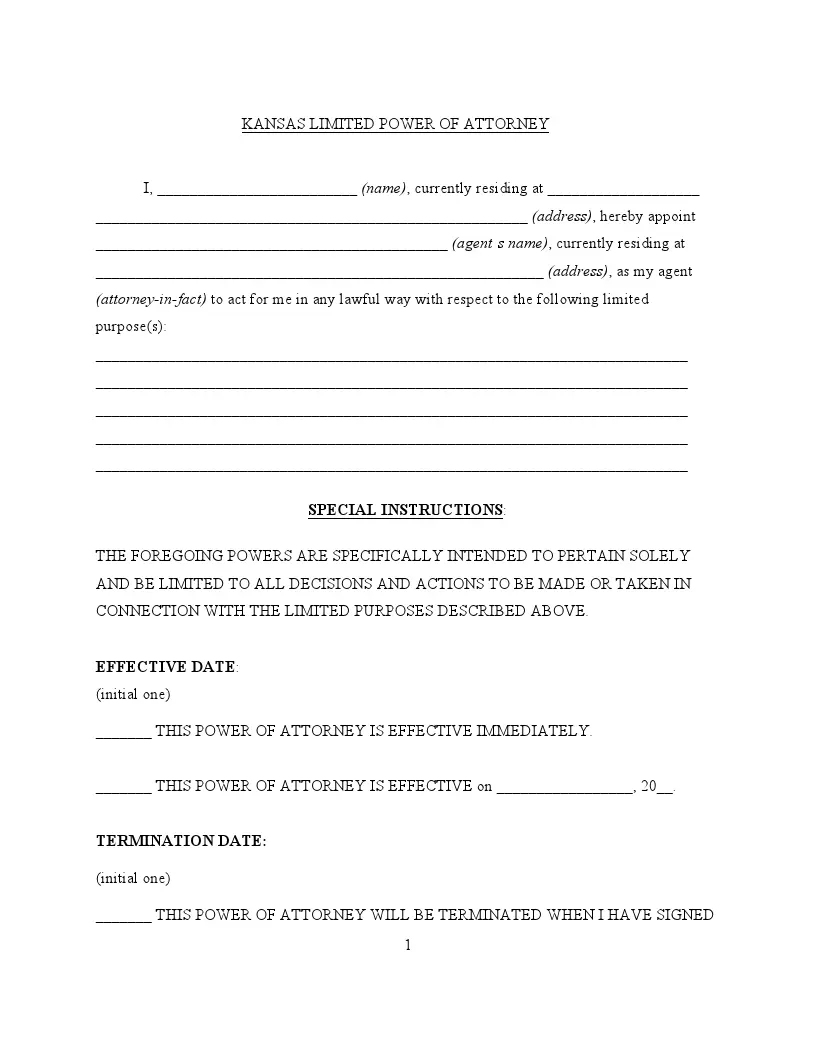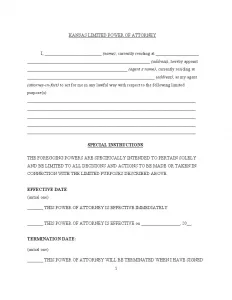Kansas Limited Power of Attorney Form
A Kansas limited power of attorney is a formal document through which an individual (known as the “principal”) authorizes another individual (known as the “agent” or “attorney-in-fact”) to carry out specific actions or decisions for them. This document is characterized by its limited scope, as it confines the agent’s authority to designated activities, events, or durations. This contrasts with a general power of attorney, which provides the agent with a wide range of powers.
The authority granted is explicitly detailed in the document. For example, the agent may be authorized to oversee real estate dealings, administer financial accounts, or direct medical choices, but specific conditions or a defined duration constrains this. This document can be established to remain effective for a designated period or until a specified event occurs, at which point it ceases automatically.
Similar to other Kansas power of attorney forms, the principal can revoke limited POA, provided they are mentally capable.

Build Your Document
Answer a few simple questions to make your document in minutes
Save and Print
Save progress and finish on any device, download and print anytime
Sign and Use
Your valid, lawyer-approved document is ready
In Kansas, the laws governing the signing requirements and overall legal stipulations for a limited power of attorney are specifically outlined under Kansas Statutes §§ 58-650 to 58-665. According to § 58-651(i), a “power of attorney” is defined as a written authorization that may be either durable or nondurable, enabling one person to act on behalf of another.
For the execution of a power of attorney in Kansas to be legally binding, § 58-652 mandates that it must include the acknowledgment of a notary public. This formal acknowledgment is crucial as it confirms the principal’s identity and ensures that the principal signs the document willingly and without coercion.
These signing requirements protect all parties involved by providing a clear legal framework supporting the validity of the Kansas limited power of attorney. This formal process helps prevent potential disputes and ensures that the document can be relied upon in legal and financial contexts where the agent acts on the principal’s behalf.
Kansas Limited Power of Attorney Form Details
| Document Name | Kansas Limited Power of Attorney Form |
| Other Name | Kansas Special Power of Attorney |
| Relevant Laws | Kansas Statutes, Section 58-654 |
| Avg. Time to Fill Out | 8 minutes |
| # of Fillable Fields | 32 |
| Available Formats | Adobe PDF |
Filling Out Kansas Limited POA
When preparing a Kansas limited power of attorney form, ensure every detail is correct to effectively grant your appointed agent the authority to act on your behalf in specific situations.
1. Principal’s Information
Provide your full legal name where indicated, followed by your complete address. This information should be accurate and reflect the same details on your identification documents.
2. Appoint Your Agent
Insert the full legal name of the person you wish to appoint as your agent, who will act on your behalf. This person, also known as the attorney-in-fact, should be someone you trust implicitly to handle the specified duties.
3. Define the Powers
Detail the specific powers you are granting to your agent. Be as clear and precise as possible. Specify any limitations or conditions under which these powers should be exercised. This section may include managing financial accounts, selling property, or handling business transactions.
4. Term of the POA
Indicate the duration for which the power of attorney will be effective. If it is intended to last until a specific event occurs, mention this event. Otherwise, provide a date on which the power of attorney will automatically expire.
5. Execution Date
Fill in the date on which the power of attorney is executed. This should be the current date when you are signing the form.
6. Witness and Notarization
The POA must be signed in the presence of a notary public. Include the state and county where the notarization is taking place. The notary will then verify your identity and witness your signature.
7. Signatures
Sign your name where indicated in the presence of the notary public. After verifying your identity and witnessing your signing, the notary will also sign the document and affix their seal, thereby notarizing the form.
8. Keep Records
Once completed, keep a copy of the POA for your records and provide another to your appointed agent. It may also be wise to give a copy to relevant financial institutions or entities requiring it.
